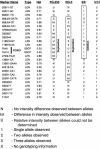A spectrum of FOXC1 mutations suggests gene dosage as a mechanism for developmental defects of the anterior chamber of the eye
- PMID: 11170889
- PMCID: PMC1235270
- DOI: 10.1086/318183
A spectrum of FOXC1 mutations suggests gene dosage as a mechanism for developmental defects of the anterior chamber of the eye
Abstract
Mutations in the forkhead transcription-factor gene (FOXC1), have been shown to cause defects of the anterior chamber of the eye that are associated with developmental forms of glaucoma. Discovery of these mutations was greatly facilitated by the cloning and characterization of the 6p25 breakpoint in a patient with both congenital glaucoma and a balanced-translocation event involving chromosomes 6 and 13. Here we describe the identification of novel mutations in the FOXC1 gene in patients with anterior-chamber defects of the eye. We have detected nine new mutations (eight of which are novel) in the FOXC1 gene in patients with anterior-chamber eye defects. Of these mutations, five frameshift mutations predict loss of the forkhead domain, as a result of premature termination of translation. Of particular interest is the fact that two families have a duplication of 6p25, involving the FOXC1 gene. These data suggest that both FOXC1 haploinsufficiency and increased gene dosage can cause anterior-chamber defects of the eye.
Figures




References
Electronic-Database Information
-
- NIH Image Home Page, http://rsb.info.nih.gov/nih-image/ (for NIH Image, version 1.62)
-
- Online Mendelian Inheritance in Man (OMIM), http://www.ncbi.nlm.nih.gov/Omim/ (for MYOC [MIM 601652], CYP1B1 [MIM 601771], PITX2 [MIM 601542], RIEG1 [MIM 180500], FOXC1 [MIM 601090], RIEG2 [MIM 601499], FOXC2 [MIM 602402], FOXF2 [MIM 603250], iris hypoplasia [MIM 308500], IRID1 [MIM 601631], and PAX6 [MIM 106210])
-
- Sanger Centre, The, http://www.sanger.ac.uk/ (for FISH analysis) and ftp://ftp.sanger.ac.uk/pub/human/sequences/ (for sequence data)
References
-
- Aalfs CM, Fantes JA, Wenniger-Prick LJ, Sluijter S, Hennekam RC, van Heyningen V, Hoovers JM (1997) Tandem duplication of 11p12-p13 in a child with borderline development delay and eye abnormalities: dose effect of the PAX6 gene product? Am J Med Genet 73:267–271 - PubMed
-
- Alward WL (2000) The genetics of open-angle glaucoma: the story of GLC1A and myocilin. Eye 14:429–436 - PubMed
-
- Blixt A, Mahlapuu M, Bjursell C, Darnfors C, Johannesson T, Enerback S, Carlsson P (1998) The two-exon gene of the human forkhead transcription factor FREAC-2 (FKHL6) is located at 6p25.3. Genomics 53:387–390 - PubMed
-
- Fingert JH, Heon E, Liebmann JM, Yamamoto T, Craig JE, Rait J, Kawase K, Hoh ST, Buys YM, Dickinson J, Hockey RR, Williams-Lyn D, Trope G, Kitazawa Y, Ritch R, Mackey DA, Alward WL, Sheffield VC, Stone EM (1999) Analysis of myocilin mutations in 1703 glaucoma patients from five different populations. Hum Mol Genet 8:899–905 - PubMed
-
- Glaser T, Jepeal L, Edwards JG, Young SR, Favor J, Maas RL (1994) PAX6 gene dosage effect in a family with congenital cataracts, aniridia, anophthalmia and central nervous system defects. Nat Genet 7:463–471 - PubMed
Publication types
MeSH terms
Substances
Associated data
- Actions
- Actions
- Actions
- Actions
- Actions
- Actions
- Actions
- Actions
- Actions
- Actions
- Actions
Grants and funding
LinkOut - more resources
Full Text Sources
Other Literature Sources
Medical
Molecular Biology Databases

